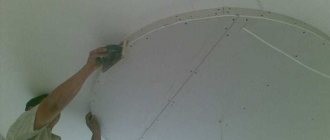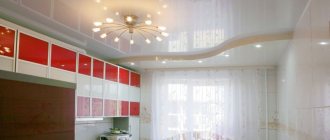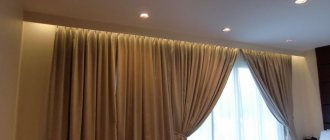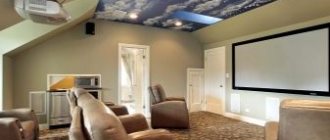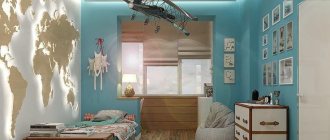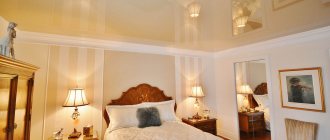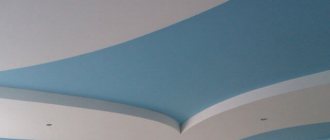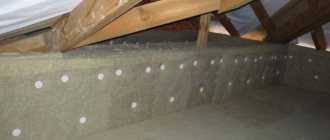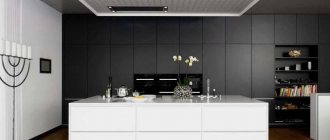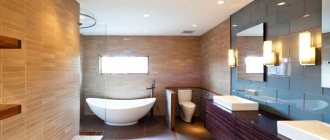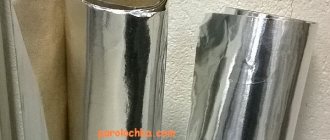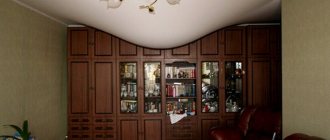Types of noise
Noises and sounds affecting the human ear are divided into two groups:
- acoustic , or air - speech, music, singing, animal voices;
- drums - stomping, sounds from falling objects, low-frequency noise from operating equipment.
Acoustic noise travels primarily through the air; when passing through the thickness of the floors, it is partially damped. The thicker and more massive the floors, the better the sound absorption . Cavities and voids in them, on the contrary, can play the role of a speaker and increase noise . Acoustic noise also travels well through cracks and gaps.
Impact sounds are most effectively dampened by finishing floors with elastic materials. It is enough to place a porous underlay under the floor covering, and the sound of footsteps and falling objects is muffled or disappears completely. A floating screed gives an even better effect. However, not all residents of modern houses are conscious and often have to solve the problem of soundproofing the ceiling on their own.
Noise propagating through interfloor ceilings
Myths about soundproofing ceilings
Experienced finishing craftsmen often encounter the results of improperly implemented noise protection, and the reason for this is common myths about the properties of various materials. Let's look at the most common of them.
Myth 1. Stretch ceiling reduces noise
Stretch ceilings made of PVC film by themselves do not have soundproofing properties. Some effect is achieved only by the air gap between the ceilings and the stretch ceiling fabric. But in some cases, if there are voids, cracks and gaps in the ceilings, a suspended ceiling can play the role of a speaker, several times amplifying the acoustic noise coming from above.
By itself, only a stretch ceiling made of acoustic fabric provides protection from extraneous sounds . It is made of high-strength PVC film, which is perforated. Sound waves are partially reflected from the canvas, and partially, passing through the perforation, change their amplitude and frequency and become imperceptible.
This fabric is more expensive than conventional PVC material, but it does not provide complete sound insulation of the ceiling and absorbs mainly sounds occurring indoors. To protect against external noise, it is better to use special soundproofing materials laid between the rough and finished ceilings.
Prices for soundproofing panels
soundproofing panels
Acoustic stretch ceiling
Myth 2. Suspended drywall creates a soundproofing air gap
Another type of finishing that can conduct sounds is drywall, mounted on hangers and guides without soundproofing pads. This design is often found when installing multi-level stretch ceilings; it has a certain rigidity and perfectly transmits impact noise. Gypsum plasterboard sheets and suspended ceiling fabric amplify acoustic noise, like a speaker.
suspensions with vibration damping for plasterboard structures . GKL sheets are attached to the guides using gaskets made of porous elastic material. Drywall is used as a sound insulator only in multilayer structures composed of materials of different densities.
Vibration suspension for suspended ceiling
Myth 3. Polystyrene foam and polystyrene foam can be used for soundproofing ceilings
Foamed polystyrene materials perfectly dampen impact noise when used in a floating floor screed. Thanks to their elasticity, they do not transmit the sound of steps and falling objects. However, when used on the ceiling, they are useless and do not protect against acoustic noise. You can use polystyrene foam and polystyrene for sound insulation under a suspended ceiling only as part of a multilayer structure alternating materials with different sound absorption. For high ceiling heights, it is permissible to use one polystyrene foam, and its layer must be at least 15-20 cm.
Ceiling soundproofing methods
There are several ways to protect your living space from external noise:
- The easiest way is to attach the soundproofing material directly to the base surface. Frameless soundproofing of the ceiling allows you to maintain the original height of the room, since there is no need to construct a lathing or frame to fix the material. The sound insulator can be glued to the ceiling, secured with dowels with caps. Frameless insulation is also performed using liquid mixtures.
- To secure soft insulators to the shelf surface, you need to build a lathing. Soundproofing of ceilings with ecowool and mineral wool is carried out using frame technology. Wooden sheathing or metal frame reduces the height of the room. To hide the supporting structure, a suspended, suspended or false ceiling is installed.
Important! Some ceiling soundproofing materials can only be installed using frameless technology, while others are suitable for installation in different ways.
Noise protection materials
Experts in protection against acoustic and impact noise for soundproofing suspended ceilings recommend using proven materials, which include:
- soundproofing plaster;
- mineral, fiberglass and basalt wool;
- porous membranes;
- complex multilayer systems made of materials with different properties.
All these materials are used for noise protection not only in residential apartments, but also in cinemas, clubs, and industrial premises. With proper calculation and installation, they can create complete isolation from extraneous sounds.
Frameless ceiling sound insulation
Thin-layer (5 mm or less) sheet or roll materials designed for additional sound insulation of walls and ceilings are now widely advertised. They are made from cork, expanded polystyrene and polyethylene foam.
The material is fixed to the concrete surface using glue. After this, it can be covered with wallpaper or painted. But additional sound insulation using thin-layer materials usually reduces noise by no more than 3 dB. It's practically unnoticeable. In addition, there is a risk of deterioration of the indoor microclimate if a material with low permeability is used.
In the case of frameless installation, multilayer structures will be more effective. They often have a soft backing made of mineral felt and a self-adhesive membrane. Sound-absorbing panels and sheet cladding are installed on this substrate.
The main element of such cladding is the panel. It can be made of pressed mineral fiber, fiberboard, cardboard with compacted sand inside.
The panels are fixed to the ceiling or walls using special acoustic dowels. After this, silicone sealant or polyurethane glue and self-tapping screws are used to install the sheathing sheets. They must be screwed directly to the panels and not to the concrete floor.
The thickness of this structure is approximately 30mm. The noise during its installation can be reduced by about 10-12 dB. The same result can be obtained when using frame sound insulation with a thickness of 60 cm.
But this is a rather expensive solution. Taking into account installation, the minimum cost is 2800 rubles per 1 sq. m. m. In addition, you will have to additionally level the base surface before installing the panels.
There are also acoustic sandwich panels on sale, which are made of a noise-absorbing layer (most often very dense mineral wool is used) and a rigid sheathing glued to it. The thickness of this structure can reach 130 mm. These panels are mounted directly on the ceiling. Sound absorption reaches 18 dB.
Soundproofing plaster
Special soundproofing plaster based on Portland cement with the addition of porous components - pumice, expanded clay, perlite, and aluminum powder. When mixing plaster with water, aluminum powder releases gas bubbles, making its structure porous and elastic. The plaster also contains polymer materials that ensure the elasticity of the coating.
Popular soundproofing plaster
Advantages of plaster:
- for effective sound insulation of the ceiling, one or two layers of coating are sufficient, their total thickness does not exceed 40 mm;
- with the help of plaster you can not only reduce acoustic noise, but also seal irregularities, cracks and crevices in the ceilings;
- plaster is applied quickly, manually or mechanically;
- the composition does not include biological components, which ensures resistance to rot and mold;
- plaster has heat-insulating properties.
The only disadvantages include the high price of the material - it is comparable to the cost of the stretch ceiling itself.
Plaster application technology
Before starting work, it is necessary to calculate the required amount of dry plaster mixture. The plaster consumption is indicated on the packaging and is usually 0.3-0.5 kg per 1 m2 of 1 mm thick coating. Thus, to obtain a minimum layer of 10 mm, 3-5 kg of mixture is required.
Sequence of work.
- Before plastering, it is necessary to clean the ceiling from the old coating - whitewash, paint or wallpaper. They are removed to a solid base using a spatula, then the ceiling is washed with warm water.
- Treat the ceiling with Betonkontakt primer. The primer is applied with a roller in one or two layers, observing the drying time between application of layers.
- The dry mixture of soundproofing plaster is mixed with water using a construction mixer, observing the dosage of water indicated on the package. Mixing time is at least 5 minutes. Leave the mixture for 10-15 minutes, mix again and begin plastering.
- Soundproofing plaster is applied to the ceiling without installing beacons - they will create sound-conducting bridges . To make the layer even, you can use temporary beacons, which are removed after leveling the coating. The plaster is applied and leveled with a wide spatula, trying to make a layer no more than 20 mm.
- If necessary, you can apply the plaster in several layers, each of which must be dried.
Applying soundproofing plaster to the ceiling
Important! A surface plastered with a soundproofing compound cannot be rubbed down or painted with viscous compounds - in this case, the pores of the material are filled and the soundproofing properties are lost.
Soundproofing plaster can protect against common household sounds: speech, dog barking, music or TV at moderate volume. If your neighbors like loud parties or host late-night movie nights in their home theater, this type of noise insulation will not be enough, and it is better to consider other methods.
Drywall prices
drywall
Mineral and basalt wool
These materials are widely used in soundproofing systems and have many advantages:
- good sound absorption and sound insulation;
- low price;
- environmental friendliness;
- Fire safety;
- easy installation.
The only disadvantages that can be noted are the significant thickness and destruction of the material when wet . Therefore, it is better not to use sound insulation based on mineral wool in rooms where leaks through the ceilings are possible.
Soundproofing the ceiling with mineral wool
The level of sound absorption of mineral and basalt wool is quite high; in residential buildings, a layer of 50-100 mm is sufficient for complete isolation from household noise. Sound insulation based on mineral fiber is produced in the form of rolls or slabs with different densities.
The method of their fastening depends on this indicator, which can be done:
- for glue – the method is suitable for slabs with a density of at least 40 kg/m3;
- into a lathing made of a bar or profile - slabs with a density of 20 kg/m3 are inserted spaced between the guides.
Note! The higher the density of the material, the worse its soundproofing properties. Lighter mineral wools provide the best protection against acoustic noise.
Technology of laying mineral and basalt wool on glue
To glue mineral-based soundproofing boards, glue based on cement or gypsum is used. It is sold in the form of a dry mixture; before starting work, it must be mixed with water in the proportion specified by the manufacturer and stirred thoroughly.
Prices for mineral wool
mineral wool
- Prepare the ceiling surface in the same way as for plaster. It is recommended to coat the surface with a primer to remove dust and improve the adhesion of the adhesive to the floors.
- The glue is applied to the slab of soundproofing material in a thin layer and leveled with a notched trowel. Lightweight boards can be glued using spray adhesive.
- Place the slab against the ceiling and gently press it, trying not to disturb its integrity.
Laying mineral wool on the ceiling using glue
- The glue takes about a day to dry. In the case of stretching PVC-based ceilings that have vapor barrier properties, no additional sound insulation coating is required. If you plan to make a suspended ceiling from fabric, it is better to insulate the slabs with a vapor-proof material - a membrane made of non-woven fabric. It is pulled over the sound insulation layer using special plastic mushroom dowels.
Video - Soundproofing a stretch ceiling with mineral wool
Technology for laying fibrous mineral insulation in lathing
The main difficulty of this method is to make the sheathing with vibration isolation, otherwise the impact noise will not be dampened, but will intensify. For vibration decoupling, special suspensions with gaskets and elements made of elastic material that dampen vibrations are used.
- Special preparation of the ceiling is not required if there are no cracks or crevices. If there are any, it is necessary to putty them and dry the putty.
- U-shaped plasterboard brackets with vibration isolation are attached to the ceiling using dowels. The profile at the points of attachment to the brackets is also insulated with elastic materials, for example, foamed polyethylene or a special sound-absorbing membrane. The guides are attached to the brackets using a level. This will help avoid large distortions.
- Soundproofing mats or slabs are placed spaced between the guides. They should fit snugly to the ceiling. If, due to the large unevenness of the ceilings, the guides have to be lowered a considerable distance, the slabs are laid in two layers: the first is slipped between the profile and the ceiling, the second is placed perpendicular to the first between the guides.
Soundproofing the ceiling with suspensions with vibration isolation
- As in the case of fastening with glue, if necessary, the surface is covered with a vapor barrier.
Important! An air gap of 50 mm is required between the sound insulation layer and the suspended ceiling. It will serve as additional protection against noise and provide ventilation between the ceiling sheet and sound insulation.
Mineral wool brands
Depending on the density, the following grades of mineral wool differ:
- P-75. It is used for laying in horizontal planes, in places where there is no heavy load. It is also used for insulation of gas pipes.
- P-125. Has high sound insulation properties. Installation is carried out both on the surface of walls and ceilings. Suitable for buildings made of brick, aerated concrete and foam block.
- PZh-175 and PPZh-200. Such brands are characterized by increased rigidity. Installation is carried out on walls made of metal or reinforced concrete structures.
Article on the topic: Soundproofing membranes for walls
Soundproofing membranes
Membrane films for sound insulation are characterized by a small thickness - up to 2 cm, so they are used under suspended ceilings if the height of the room is small and every centimeter counts. Their soundproofing properties can be compared to a five-centimeter layer of mineral wool.
The membranes consist of several layers with different elasticity and sound absorption. For the manufacture of these materials, polyethylene foam, fiberglass, non-woven material and thin lead plates are used in various combinations. Membranes can be supplied in the form of rolls or slabs. The table provides an overview of soundproofing membranes.
Table. Soundproofing membranes.
| Illustration | Name, features | Options |
| Topsilent Bitex (Polipiombo) Fiberglass coated on both sides with polypropylene fabric. | Roll material, thickness 4 mm, width 0.6 m. Sound insulation up to 24 dB. They are attached to the ceilings using Fonocoll glue. | |
| Tecsound Aragonite (calcium carbonate), covered on one side with non-woven material. | Roll material with high density, thickness 3.7 mm, width - 1.2 m. Sound insulation up to 28 dB. They are attached to the ceiling with glue. | |
| Akustik-Metal Slik Lead foil 0.5 mm thick, coated on both sides with polyethylene foam. | Roll size 3x1 m, thickness 6.5 mm. Sound insulation up to 27.5 dB. They are attached to the ceiling using Fonocoll glue. | |
| Zvukanet Universal Fiberglass in a polypropylene membrane. | Roll, size 0.7x10 m or 1.55x10 m. Thickness 14 mm. Sound insulation up to 22 dB. |
Despite the different composition, the technologies for attaching membranes to the ceiling are not much different from each other. The main stages of covering the ceiling with soundproofing membranes are described below.
Technology for attaching the membrane to the ceiling
Calculation of the membrane and glue is carried out based on the area of the room. Membrane manufacturers recommend Fonocoll adhesive with water-based styrene acrylic resins . The adhesive is suitable for gluing any acoustic materials to concrete, drywall or wood.
- Ceiling preparation is carried out if there is peeling paint or plaster on it. They are cleaned to a solid base, after which the cracks and cracks are sealed, and the seams are puttied. The smoother the base, the better its contact with the membrane and soundproofing properties.
- The adhesive must be applied in a thin layer to the underside of the soundproofing membrane and to the ceiling. This can be done conveniently with a spatula or brush. The glue is kept for about 15 minutes, after which the membrane is applied to the ceiling and rolled with a hard roller. The strips are glued end to end.
- Complete drying of the glue takes at least a day, after which you can begin stretching the ceiling.
Soundproofing membrane
Note! Complete soundproofing of the ceiling can be achieved by using soundproofing membranes as part of multilayer structures.
Features of floor soundproofing
Sound insulation of the floor base is carried out using two methods - using the “floating floor” technology or using wooden joists. The first option involves laying an elastic soundproofing material between the screed and the finishing coating, which absorbs extraneous sounds and impacts. The optimal solution for implementing sound insulation in an apartment is ISOVER mineral wool slabs based on quartz, which are characterized by increased elasticity and, as part of the system, provide sound insulation from impact noise up to 35-37 dB.
Laying mineral wool on wooden logs is carried out with the construction of a frame. The bars are placed at a distance of 600 mm from each other and secured to the floor through a damper tape. Mineral wool is placed in the cavities between the joists without additional fixation. When cutting along the edges of the material, it is necessary to leave allowances of 10–20 mm, which will ensure a tighter fit to the frame. The top of the slabs is covered with OSB or moisture-resistant plywood, sealing the joints and the perimeter of the junction with the walls with sealant, and then finishing is carried out.
As you can see, mineral wool is a universal soundproofing (sound-absorbing) material for walls, ceilings and floors. With its help, you can effectively soundproof rooms and ensure comfortable living without paying attention to extraneous noise.
Complex multilayer systems
Such systems include professional sound insulation, consisting of several soundproofing materials with different properties. As a rule, elastic and rigid materials are laid sequentially. Passing through them, sound waves constantly change amplitude, while part of the sound energy is converted into heat.
To create such a soundproofing cake, conventional soundproofing materials are used in different combinations. Elastic vibration-absorbing membranes are placed directly on the floors, and profile lathing is installed on top of them. Mineral wool is laid between the guides using the above technology, then plasterboard is placed along the guides in one or two layers. Leave an air gap and stretch the stretch ceiling fabric.
Prices for basalt wool
basalt wool
Ceiling soundproofing installation
Find out which system to choose for ceiling soundproofing! You may also be interested in how to insulate the ceiling of a private house with your own hands. Only detailed instructions!
Such a multilayer system perfectly protects against any noise, but significantly lowers the ceiling level and requires serious costs. For these reasons, it is rarely performed in residential areas.
The technology of soundproofing under a suspended ceiling is quite simple, the costs of soundproofing materials are not too high, and the effect of even inexpensive materials is immediately noticeable. Sound insulation under a suspended ceiling is not a luxury, but a way to achieve peace, quiet and comfort in your home.
Need to remember
About sound insulation under a suspended ceiling you need to remember the following:
- a suspended ceiling has minimal ability to dampen and reflect sounds, like any other fabric or PVC film;
- An acoustic ceiling with perforated fabric reduces echoes from sounds occurring indoors. It does not protect against noise from the upper apartment;
- Sound insulation and suspended ceilings are done together. This method allows you to gain in ceiling height;
- sound insulation on a frame is more effective than without it;
- the frame is mounted on vibration suspensions;
- the places where the profiles come into contact with the sheathing and the sheathing with the walls are separated by damper tape;
- The joints between the sheathing sheets are filled with acoustic sealant.
The main thing is that work on soundproofing the ceiling should be carried out by professional craftsmen. Installation flaws and shortcomings will lead to you spending money, but you will still be aware of the events happening in your upper neighbors.
Share
